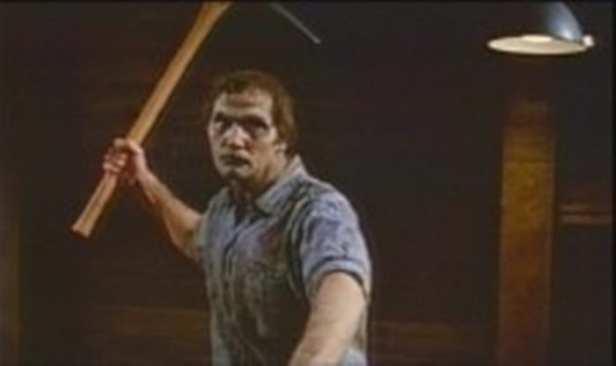John Hayes’ Garden of the Dead – also known as Tomb of the Undead – is a peculiar film, not particularly a good one but not entirely unlikable either. It’s a zombie film from a time just after George Romero’s Night of the Living Dead (1968) but before the genre had been properly codified and as such it plays fast and loose with what have become the rather too rigidly defined “rules” developed in the years since. It’s still able to do something different and very odd with the zombie film and although it’s far from a total success its willingness to be a bit “out there” makes it infinitely preferable to the plethora of cheap zombie apocalypse horrors of more recent years.
Camp Hoover prison work facility is situated in the woods of Colorado and the inmates find release from the monotony of their everyday existence by getting high on the fumes given off by a vat of formaldehyde. After a failed attempt at a mass breakout, eight of them are gunned down by the sadistic warden (Phil Kenneally) and his cronies, their bodies buried in the grounds. But as a consequence of their formaldehyde misuse causes them to return to a sort of life as zombies looking for revenge against not only their killers but the whole human race.

The performances are all below par and technically the film only just passes muster, Hayes, a veteran who had started out making short films in the 1950s, only occasionally showing flashes of style or finesse. Although it runs just shy of an hour there are many longueurs in Daniel Cady and John Jones’ script – the zombies themselves don’t turn up until 27 minutes – almost half the film having passed by – with far too much time wasted on “getting to know you” business involving the uninteresting convicts. There’s also a sappy love story thrown in for good measure between convict Paul (Marland Proctor) and ill-tempered waitress Carol (Susan Charney) that no-one’s particularly interested in
But for all that there’s plenty to enjoy here. The zombies (all eight of them – it’s not a terribly well-resourced film) are inconsistent but interesting – they lumber about and growl in the manner of the “ghouls” in Night of the Living Dead but are capable of sudden bursts of speed and can even talk, anticipating developments in films made four decades or so later. They’re formaldehyde junkies, more interested in getting high on it than eating brains, they foam at the mouth when shot and they’re on some sort of ill-defined mission against the human race (“we will destroy the living” they chant at regular intervals). They’re not very well developed and it’s not clear that Hayes, Cady, Jones or anyone else involved in the film had any idea what to do with them once they’d resurrected them, though there have a nice (albeit inevitably unexplained) vulnerability to light which comes into play in an effective sequence in the climax where the human survivors try to evade the clutches of the undead in the pool of light from an intermittently failing spotlight.

The zombie and muted gore effects were handled by Joe Blasco, another Hollywood veteran who had worked his way up through a variety of television shows to become personal make-up artist to the likes of Orson Welles, Marlene Dietrich, Lauren Bacall and Bette Midler. He was also a pioneering special effects artist, creating make-up effects out of almost nothing for films like Ilsa She Wolf of the SS (1975), The Werewolf of Woodstock (1975) and David Cronenberg’s breakthrough film Shivers (1975) and often being credited with the early use of the kind of bladder effects later refined by Rob Bottin for The Howling (1981) and Rick Baker for An American Werewolf in London (1981).
Hayes – who had mainly been working in low budget sexploitation, exploitation and horror films – manages a few memorable scenes on his clearly restricted budget. The mobile home sequence, with the undead slaughtering the owners of one trailer before besieging the young woman who witnessed their depredations – is particularly well done, one of the film’s more atmospheric and genuinely unnerving moments.

Garden of the Dead was originally released in 1972 but was more widely seen a couple of years later when it was double-billed with Hayes’s own Grave of the Vampire (1972), a far less interesting take on another of horror cinema’s staple monsters. His other genre work includes the little known Dream No Evil (1971), the surreal pornographic film Baby Rosemary (1976) (which despite claims really has nothing to do with Rosemary’s Baby (1968) beyond the title), and the End of the World (1977), a notorious dreadful science fiction cheapie with Christopher Lee as an alien. Be under no illusion about Garden of the Dead – it’s really not a very good film at all. But in its own under-funded, unambitious way and for all its flaws, Garden of the Dead is a strangely quite fascinating film and, as already noted, still looks so much better than most shot-on-video no-hopers.